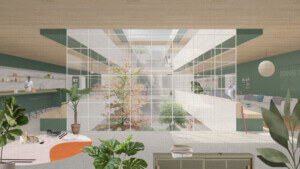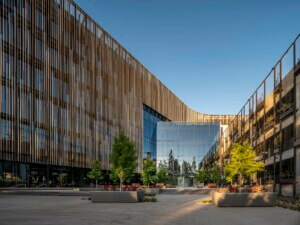If you’re looking for change in San Francisco, look no further than the city’s South of Market (SoMa) neighborhood. Central SoMa, a 24-square-block area between the central business district and Mission Bay, has been targeted for up-zoning and other public improvements as part of the Planning Department’s Central SoMa Plan (previously the Central Corridor Plan). The neighborhood is also the site of several major construction projects, including a $56 million renovation of the Moscone Center and the extension of Muni’s T Third Line.
All of the above may be affected by another potentially more radical change: Central SoMa has been identified as San Francisco’s first eco-district, as we reported last year. The district has taken some big steps since we last checked.
The eco-district concept—as realized in Seattle, Washington, D.C., Brooklyn, Denver, and elsewhere—takes a neighborhood-level approach to confronting environmental concerns. The goal is to maximize sustainable infrastructure by aggregating demand and coordinating implementation. In an eco-district, multiple property owners might choose to make a group purchase of alternative energy systems, for instance, or share greywater for reuse. An eco-district is a network of public and private partnerships, and thus goes beyond both planning policy and individual responses to ecological concerns.
The Central SoMa Eco-District project is chugging along, thanks to a set of task-force recommendations [pdf] published in November. The task force included representatives of the city’s Planning Department, Department of Environment, Department of Public Health, and Public Utilities Commission, as well as advocacy groups and several design and building firms. It identified nine performance areas for consideration: energy, water, materials management, habitat/ecosystem function, equitable development, health and well-being, community identity, access and mobility, and economic development. In addition to brainstorming project opportunities for each area, the group recommended the formation of a steering committee to identify, manage, and measure eco-district goals.
According to Kate McGee, lead planner at the San Francisco Planning Department, the Central SoMa Eco-District is in the second of three developmental phases: The first, over the past two years, involved educating San Franciscans. The second and current phase is what McGee calls questioning. The third phase is change.
Of the questions being asked, McGee identified three as the most important. The first: what does the Central SoMa Eco-District mean to me? The Planning Department is working with large-scale developers to weigh the costs and benefits of particular infrastructure developments. For smaller developers, meanwhile, the city is considering requiring an assessment to identify a parcel’s environmental potential within the context of the eco-district as a whole.
The second question is what will the Central SoMa Eco-District require me to do? To help the community along, the Planning Department has collected and is aggregating data on current district performance. “We’re going to take the first step and say, ‘here’s where you are,’ then say, ‘let us know what you want to do and how we can help,’” said McGee.
The final question is how will the Central SoMa Eco-District be implemented, monitored, and managed? The task force has recommended that a steering committee consider some initial goals for the eco-district and decide how they might be implemented. The committee will consider from several oversight structures available, including forming a non-profit or establishing a Joint Powers Authority, before the city moves forward with financing the eco-district.
While San Francisco’s first eco-district remains, in some sense, theoretical, its successful realization could bring tangible financial, environmental, and public-health benefits to residents of Central SoMa. “In many respects it really is quite preliminary,” said McGee. “But I feel that once we get the structure in place, things will move really quickly.” She is eager for the final phase of eco-district development. “When we get through the questioning,” she said, “we will then start to create change.”










